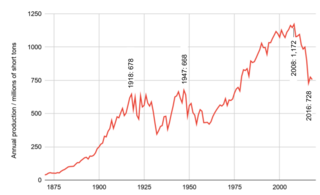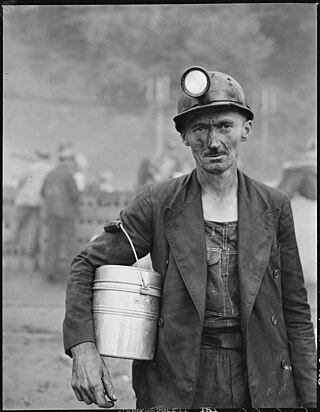Related Research Articles

The City of Lafayette is a home rule municipality located in southeastern Boulder County, Colorado, United States. The city population was 30,411 at the 2020 United States Census.

John Llewellyn Lewis was an American leader of organized labor who served as president of the United Mine Workers of America (UMW) from 1920 to 1960. A major player in the history of coal mining, he was the driving force behind the founding of the Congress of Industrial Organizations (CIO), which established the United Steel Workers of America and helped organize millions of other industrial workers in the 1930s, during the Great Depression. After resigning as head of the CIO in 1941, Lewis took the United Mine Workers out of the CIO in 1942 and in 1944 took the union into the American Federation of Labor (AFL).

The United Mine Workers of America is a North American labor union best known for representing coal miners. Today, the Union also represents health care workers, truck drivers, manufacturing workers and public employees in the United States and Canada. Although its main focus has always been on workers and their rights, the UMW of today also advocates for better roads, schools, and universal health care. By 2014, coal mining had largely shifted to open pit mines in Wyoming, and there were only 60,000 active coal miners. The UMW was left with 35,000 members, of whom 20,000 were coal miners, chiefly in underground mines in Kentucky and West Virginia. However it was responsible for pensions and medical benefits for 40,000 retired miners, and for 50,000 spouses and dependents.

Philip Murray was a Scottish-born steelworker and an American labor leader. He was the first president of the Steel Workers Organizing Committee (SWOC), the first president of the United Steelworkers of America (USWA), and the longest-serving president of the Congress of Industrial Organizations (CIO).

The Coal strike of 1902 was a strike by the United Mine Workers of America in the anthracite coalfields of eastern Pennsylvania. Miners struck for higher wages, shorter workdays, and the recognition of their union. The strike threatened to shut down the winter fuel supply to major American cities. At that time, residences were typically heated with anthracite or "hard" coal, which produces higher heat value and less smoke than "soft" or bituminous coal.

The Harlan County War, or Bloody Harlan, was a series of coal industry skirmishes, executions, bombings and strikes that took place in Harlan County, Kentucky, during the 1930s. The incidents involved coal miners and union organizers on one side and coal firms and law enforcement officials on the other. The Harlan County coal miners campaigned and fought to organize their workplaces and better their wages and working conditions. It was a nearly decade-long conflict, lasting from 1931 to 1939. Before its conclusion, an unknown number of miners, deputies and bosses would be killed, state and federal troops would occupy the county more than half a dozen times, two acclaimed folk singers would emerge, union membership would oscillate wildly and workers in the nation's most anti-labor coal county would ultimately be represented by a union.
The Progressive Miners of America was a coal miners' union organized in 1932 in downstate Illinois. It was formed in response to a 1932 contract proposal negotiated by United Mine Workers President John L. Lewis, which reduced wages from a previous rate of $6.10 per day to $5.00 per day.
The bituminous coal miners' strike was an unsuccessful national eight-week strike by miners of bituminous coal in the United States, which began on April 21, 1894.
The Bituminous coal strike of 1974 was a 28-day national coal strike in the United States led by the United Mine Workers of America. It is generally considered a successful strike by the union.
The Bituminous coal strike of 1977–1978 was a 110-day national coal strike in the United States led by the United Mine Workers of America. It began December 6, 1977, and ended on March 19, 1978. It is generally considered a successful union strike, although the contract was not beneficial to union members.
The Westmoreland County coal strike of 1910–1911, or the Westmoreland coal miners' strike, was a strike by coal miners represented by the United Mine Workers of America. The strike is also known as the Slovak Strike because about 70 percent of the miners were Slovak immigrants. It began in Westmoreland County, Pennsylvania, on March 9, 1910, and ended on July 1, 1911. At its height, the strike encompassed 65 mines and 15,000 coal miners. Sixteen people were killed during the strike, nearly all of them striking miners or members of their families. The strike ended in defeat for the union.
The Cape Breton coal strike of 1981 was a strike by coal miners who were members of the United Mine Workers of America against the Cape Breton Development Corporation (DEVCO) of Cape Breton Island, Nova Scotia, Canada. The strike, which was bitter and violent, began in the middle of July 1981, and ended in early October of that year.

The history of coal mining in the United States starts with the first commercial use in 1701, within the Manakin-Sabot area of Richmond, Virginia. Coal was the dominant power source in the late 1800s and early 1900s, and although in rapid decline it remains a significant source of energy in 2023.

The 1892 Coeur d'Alene labor strike erupted in violence when labor union miners discovered they had been infiltrated by a Pinkerton agent who had routinely provided union information to the mine owners. The response to the labor violence, disastrous for the local miners' union, became the primary motivation for the formation of the Western Federation of Miners (WFM) the following year. The incident marked the first violent confrontation between the workers of the mines and their owners. Labor unrest continued after the 1892 strike, and surfaced again in the labor confrontation of 1899.
The Pana riot, or Pana massacre, was a coal mining labor conflict and also a racial conflict that occurred on April 10, 1899, in Pana, Illinois, and resulted in the deaths of seven people. It was one of many similar labor conflicts in the coal mining regions of Illinois that occurred in 1898 and 1899.

The Illinois coal wars, also known as the Illinois mine wars and several other names, were a series of labor disputes between 1898 and 1900 in central and southern Illinois.

People have worked as coal miners for centuries, but they became increasingly important during the Industrial revolution when coal was burnt on a large scale to fuel stationary and locomotive engines and heat buildings. Owing to coal's strategic role as a primary fuel, coal miners have figured strongly in labor and political movements since that time.
The Carbon County Strikes took place in Carbon County, Utah from 1903–1904. The strikes primarily consisted of Slavic and Italian immigrant mine workers who partnered with the United Mine Workers of America strikes in Colorado to protest the dangerous working conditions of the Utah coal mines. The Carbon County strikes were considered the most important labor confrontation in the United States at the time. The Utah Fuel Company strongly opposed initiatives to unionize coal workers in Utah and were the primary opposition to the UMWA at the time. The Carbon County Strikes would ultimately fail in its attempt to unionize the coal workers of Utah simply because it "did not have enough support, either internally or externally, to win against a powerful and influential company that effectively played on radical, anti-foreign sentiments in defending its position" but it demonstrated a significant nationwide effort in strengthening unionization in the west.

The United Mine Workers coal strike of 1919 saw bituminous coal miners strike for over a month, from November 1 to December 10, 1919, for better wages.
Bituminous Coal Operators Association (BCOA) is a coal mining lobbying organization. It was founded in 1950 by various companies to deal with the UMWA and unionizing of mines during the change from human labor to mechanical labor. The BCOA would strike deals between miners, mine companies, and coal buying companies to provide a steady flow of continuous labor and a steady purchasing price for coal. The main deals normally contained negotiations of some miners being put out of work by mechanizations while the miners left would be guaranteed a steady job and pay as long as they agreed to not hold up progress with strikes and other activities. In addition, the BCOA hears requests from the UMWA employees for pay raises but often results in unprotected employees being laid off after a deal has been reached. The current president of BCOA is David M Young. He is the main representative for the BCOA and lobbyist.
References
- 1 2 3 4 5 6 7 8 9 10 Filippelli, Ronald L. (July 1976). "Diary of a Strike". Pennsylvania History. Pennsylvania State University, Pennsylvania History. 43 (3): 253–266. Archived from the original on February 4, 2014.
- 1 2 McDonald, David J.; Lynch, Edward A. (1939). Coal and Unionism. Cornelius Printing Co. pp. 173–175.
- 1 2 3 4 5 6 7 8 9 10 "Historical Markers". explorepahistory.com.
- ↑ "The West Virginia Coal Mine Wars". GlobalSecurity.org.
- 1 2 3 4 5 6 7 8 9 "Confrontation at Rossiter". Virtual Museum of Coal Mining in Western Pennsylvania. Archived from the original on 2012-06-21. Retrieved 2013-05-23.
- ↑ "Pittsburgh Coal Strike". Indiana Evening Gazette. March 12, 1921: 21–22, 1921.
{{cite journal}}: Cite journal requires|journal=(help) - ↑ Kanarek, Harold K. (1975). "The Pennsylvania Anthracite Strike of 1922". The Pennsylvania Magazine of History and Biography. The Historical Society of Pennsylvania. 99 (2): 207–225. JSTOR 20090945.
- ↑ "1922 Coal Strikes". 1920sera.com. Archived from the original on February 1, 2014.
- ↑ Zieger, Robert H. (1969). "Pennsylvania Coal and Politics". The Pennsylvania Magazine of History and Biography. Historical Society of Pennsylvania. 93 (2): 244–262. JSTOR 20090294.
- ↑ "Judge Jonathan Langham". mcintyrepa.com. Archived from the original on August 17, 2002.